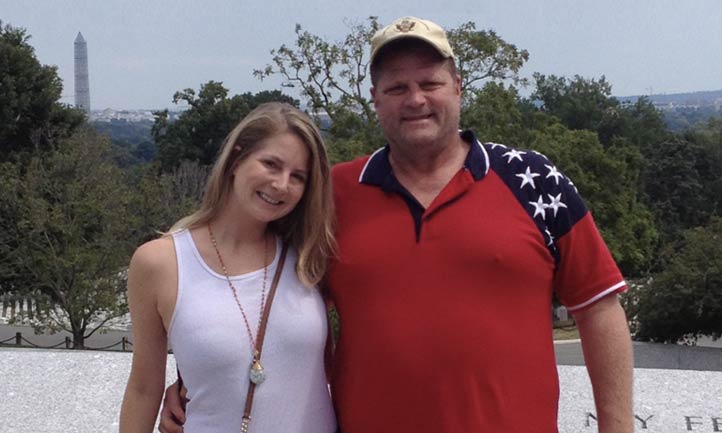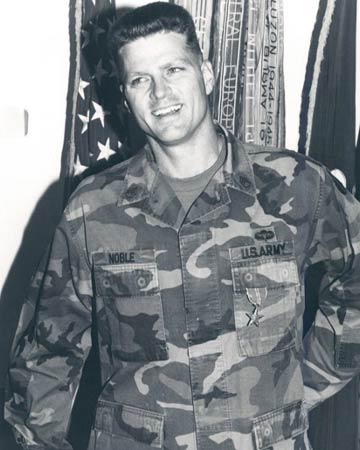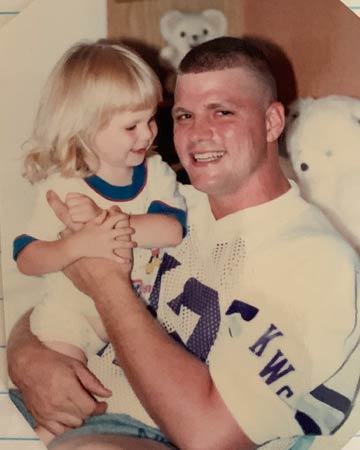Breaking the Silence as a Survivor of Murder-Suicide Loss
Author: Brittany Noble McCarthy
“Couple Dead in Murder-Suicide,” read one headline following the deaths of my dad and stepmother in January 2018.
Rooted in his determination to take his own life, Dad’s final act precluded him from a burial with military honors after serving the country for 20 years as an enlisted Army sergeant with multiple combat tours. The headlines precluded him from being thought of as anything but his final act.
As a survivor, I too was precluded. I could not grieve fully and privately without glaring headlines about the case. Aside from TAPS, I couldn’t find an organization willing to help me with the complexities surrounding the situation, or even one that seemed able. I struggled to find anybody sharing a personal experience publicly with murder-suicide.
I concluded I shouldn’t talk about it either. I felt alone, left to live out the rest of my existence cloaked in guilt and shame as I let the headlines define me.

Murder-suicide, as the media labeled it, became my dirty little secret. I broke myself in half to survive.
My Suicide Half mourned Dad. I went back to work at my corporate job, head held high. I tucked the shame away as tidily as I imagined a FedExed box of Dad’s remains, had I chosen cremation. My Murder Half remained hidden, as if behind a wall; my Suicide Half occasionally peering over it with a look of disdain.
I know what everybody must think: Killers are monsters. As Dad’s daughter, this made me half-monster. I did not deserve to mourn my stepmother, whom Dad had killed. I did not deserve to feel brokenhearted; I was estranged from Dad when he died and had been on and off throughout my life. I did not deserve to tell my story. I spoke in quiet half-truths wherever I went, from stuffy churches hosting suicide loss support groups to the hallways at work where I’d chit chat with colleagues. Every time I tried to utter the term “murder-suicide,” nothing came out.
At war with myself, I lived like a liar.
Murder-suicide. I searched the grim term online regularly, hoping to find somebody like me. I was met with sensational headlines and carelessly rendered facts or the occasional anonymously penned survivor story. I pictured reporters as ghouls devouring their hand-delivered juicy meal each day. One part murder. One part suicide. One perfect piece of click-bait.
When I received the 54-page crime scene report detailing what was known of their final moments, I read it in its entirety. Fifty-four pages: One for each year of Dad’s life. My brain became a case file: autopsies, transcripts and evidence.
The images splashed across the news haunted me for months. I learned many details in lockstep with the public: Police crowded outside the cute double-wide manufactured home my dad and stepmother shared on the corner of a cul-de-sac decorated with yellow crime scene tape.
None of the reports mentioned two months before the end. How Dad chucked any identifying possessions he had into the woods, save a cell phone, and hid in a port-a-potty for hours making frantic calls. How for years bright lights and loud noises would spur him into panic attacks, symptoms temporarily appeased by a cocktail of antipsychotics and medical marijuana.
How Dad suffered from posttraumatic stress and was convinced our country’s enemies were tracking him wanting revenge for the atrocities he believed he committed. How, on that day in November, he believed the world was ending. His mother was able to coax him into going home during their phone conversation. Soon after he did, he returned home and, with his wife’s support, admitted himself to a behavioral health facility for two weeks.
How that was Dad’s last attempt after years of trying to get help. How nothing could save him from his thoughts.
The 18 months following the murder-suicide were the toughest of my life. Without much information to cling onto in my grief, I grasped at myths and misinformation. I believed I was nothing more than a murderer’s daughter.
The triggers hit me unexpectedly. One day a colleague gestured his annoyance at a project by pointing two fingers and a raised thumb at his head, reminding me of all I’d learned about Dad’s death. Acquaintances and distant family members made jokes about the “looney bins” and the “crazies” constantly.
I’m sure nobody meant any harm. In fairness, because of my shame, most people didn’t know my personal connection to mental illness or suicide. I became part of the problem when I chose to suffer in silence and hopelessly accepted the stigma of my situation was too great. I succumbed to the idea most people didn’t have malleable hearts, let alone the time to understand the complexities of mental health.
Yet murder-suicide headlines kept coming. Sometimes many a day from states across the country. I couldn’t help but think of the people impacted who may have nowhere to turn. People like me.
I decided to start down a path to understand the truth.
Journey to Understanding the Truth
Dad’s case sat open for almost two years. Not because there were ongoing investigations or unsolved questions from a legal standpoint, but simply because the overwhelmed small town sheriff’s department forgot to officially do so. When I followed up about Dad’s personal belongings listed in the crime scene report in November 2019, including his mental health paperwork, I was sickened at the thought of the information collecting dust in a steel locker.
The reports from media and law enforcement didn’t include facts on Dad’s mental health, though they did include ignorant remarks from investigating officers who spewed diagnoses without proof of their claims.
“I heard he was schizophrenic,” offered one officer. Neighbors interviewed said Dad “had been acting really weird,” and they “knew he was struggling with prior military involvement.”
If they’d read the paperwork, they’d have known the truth. At least a fuller story.
Somehow still, the case and the half-story was stamped permanently into history within a week: “He had received mental health counseling” and “the couple had domestic violence issues” in the past, read the news articles.
I guess nobody cared enough to look at the papers. It’s easy to make an open and shut story — a simple headline — when you have the power. Maybe I was the only who cared.
Can you recall a time you saw a headline on murder-suicide? If so, did you click on it? Perhaps you breezed past it without much thought at all. Perhaps you paused to feel for those involved, thankful it didn’t happen to your family or in your community. If you’re like many, you may also make some well-meaning assumptions. The incident must certainly be related to domestic violence — a crime of passion: the perpetrator killed somebody in a jealous rage and, horrified by the reality of their action, took their own life out of fear of the legal or emotional consequences they’d certainly face.
Here are some facts: Research shows these incidents are rarely, if ever, a crime of passion. In fact, the act most often has more in common with suicide than murder. It usually starts with an individual’s intent to take their own life, not another’s.
I was surprised to learn those who take their lives along with another’s have much more in common with those who take their own lives alone. Murder-suicides and suicides most often tend to occur on the same days of the week (Mondays). In both, perpetrators have high instances of mental illness whereas in murders absent suicide do not.
Facts helped me accept what happened as a whole act and understand suicide is at the core.
I remember waking up to Dad’s seven panicked voicemails one morning in 2013: “Britt, something is wrong. You have to get out of D.C. The terrorists are after me and they are after you. They are going to attack. You need to call me back immediately,” he said. I called him back repeatedly, fearing the worst had happened, until he answered. I sighed in relief.
I remember the public rants he posted on social media in 2015: “Treat Brittany wrong and I will hunt you to the ends of the earth. When the radical extremists come for you I won’t consider you worthy, but I will help my daughter.” I called the local police who promised to conduct a welfare check. I knew he had weapons. When I called them back hours later the officer said, “Everything was fine.” I had no relief.
Everything was not fine. Dad was broken and I could not save him. I was terrified of losing him and what he might do in his mental state.
Three years later, almost to the day, my biggest fear came true. To escape his pain, Dad took his own life. For reasons I will not ever know, he also took his wife’s. Complex nuances hit me hard as I pieced myself back together to live.

Here's a hard truth: Dad was so much more than his final act. He was a helper full of stories in war-trodden countries. He helped the children in those areas by sharing soccer balls or candy. He was funny when he shared off-the-wall tales of the friendly Daddy-Longleg spider, Edmund, who followed us loyally to each government-owned dwelling we inhabited, watching over us. He was hilarious when he gave me silly nicknames like Brittle-Bree, Pingle and Pongle. He was a soldier who loved his country, a regimented and strict father who never let me stay up past bedtime or miss school. He was blazing hot anger, Coca-Cola and Kentucky bourbon, somebody who left to pick up pizza when I was young and didn’t return for days. Our relationship was marred with estrangement, broken promises and fleeting flecks of beauty and hope. I always loved him and always will.
Here's a harder truth: As much as I hated Dad’s final act, it should not define him. I heaped guilt onto myself, feeling I had to do more and be stronger as if I could somehow change the horrible reality, no matter what it cost me personally or emotionally. As Dad’s daughter I did the best I could when faced with wrenching decisions and deadlines in the days following the murder-suicide, such as what to do with his body, how to ship his remains across state lines and what to write in his obituary. I’ll never know if I made the right choices. I don’t know if there were any right choices to be made.
But I do know he was a person – both flawed and good.
Journey to Healing
The work to heal has not been easy. It’s been terribly uncomfortable and tragically eye-opening, as life and truth almost always are.
First, I was fortunate to have found an incredible support network in TAPS, who treated me equally, regardless of the circumstances that led me to them. Above all, they’ve worked with me to explore this incredibly complex situation as I seek to respectfully share my experience, spark a national conversation and provide more options for survivors to navigate life in the aftermath of losing loved ones in this way.
Second, I’ve come to better understand the way Dad’s life ended through stories of compassion and science. Two books in particular helped me: Dr. Edward W. Beal’s “War Stories from the Forgotten Soldiers” and Dr. Thomas Joiner’s book, “The Perversion of Virtue.” Beal provides a heartfelt look at warfighters left behind once they return to America through a series of essays written from his time as a psychiatrist on the front lines at a veteran’s hospital. Joiner’s research helped me wade through uncomfortable waters and realize I am a survivor of this type of loss, just as those who lose a loved one to suicide are survivors.
Finally, I’ve found the strength to use my voice. In the two years since my experience with murder-suicide loss, the daily headlines on the topic haven’t just stopped me in my tracks, they’ve encouraged me to think hard about how these half-stories and labels shape public perception of these tragedies and can impede the healing of those left behind. Now, I feel strong enough to speak out. I’ve found purpose in taking this terrible experience and helping others understand the realities and people behind this rare final act, which, believe it or not, is an everyday occurrence in the United States.
As I write this, murder-suicides have hit headlines and impacted families, friends and communities in California, Kentucky, Michigan and Pennsylvania in the last 24 hours alone.
Working Together

In meeting with other survivors, I’ve learned there is so much more to their stories than the headlines. Some have never thought of themselves as survivors. Some kept the act hidden secretly for decades. Some have a strong aversion to the term “murder-suicide.” Many feel it’s just too taboo to talk about publicly, despite the fact those left behind did nothing wrong.
Because murder-suicide is fairly under-researched, the available facts are somewhat controversial in the mental health field. It’s no wonder survivors may feel like a walking controversy. I know I did.
Without all involved using the same language, many new survivors will feel isolated.
All survivors of tragedy deserve compassion, grace, truth, normalized language and humanization regardless of the circumstance or their relationship to the victims and perpetrators. I understand the guilt and shame of the situation is not mine to carry and I refuse to let the headlines be the only story — mine or Dad’s.
Law enforcement, media, nonprofits, mental health professionals, academia and survivors must work together so nobody is left to navigate this type of situation alone. We must do better, together.
Brittany Noble McCarthy is the surviving daughter of Army veteran Joseph David Noble, II. Her writing humanizes the often sensationalized topic of murder-suicide to increase understanding and encourage conversation. She is working on her memoir. Find her on Twitter @BritMcCar.
Photos courtesy of Brittany Noble McCarthy
RESOURCE
If you are struggling with suicidal thoughts or inclinations, reach out immediately to the Suicide Prevention Lifeline at 1-800-273-8255 which provides 24/7, free and confidential support for people in distress, and prevention and crisis resources for you or your loved ones.
